2017 NISSAN LEAF warning
[x] Cancel search: warningPage 2 of 424
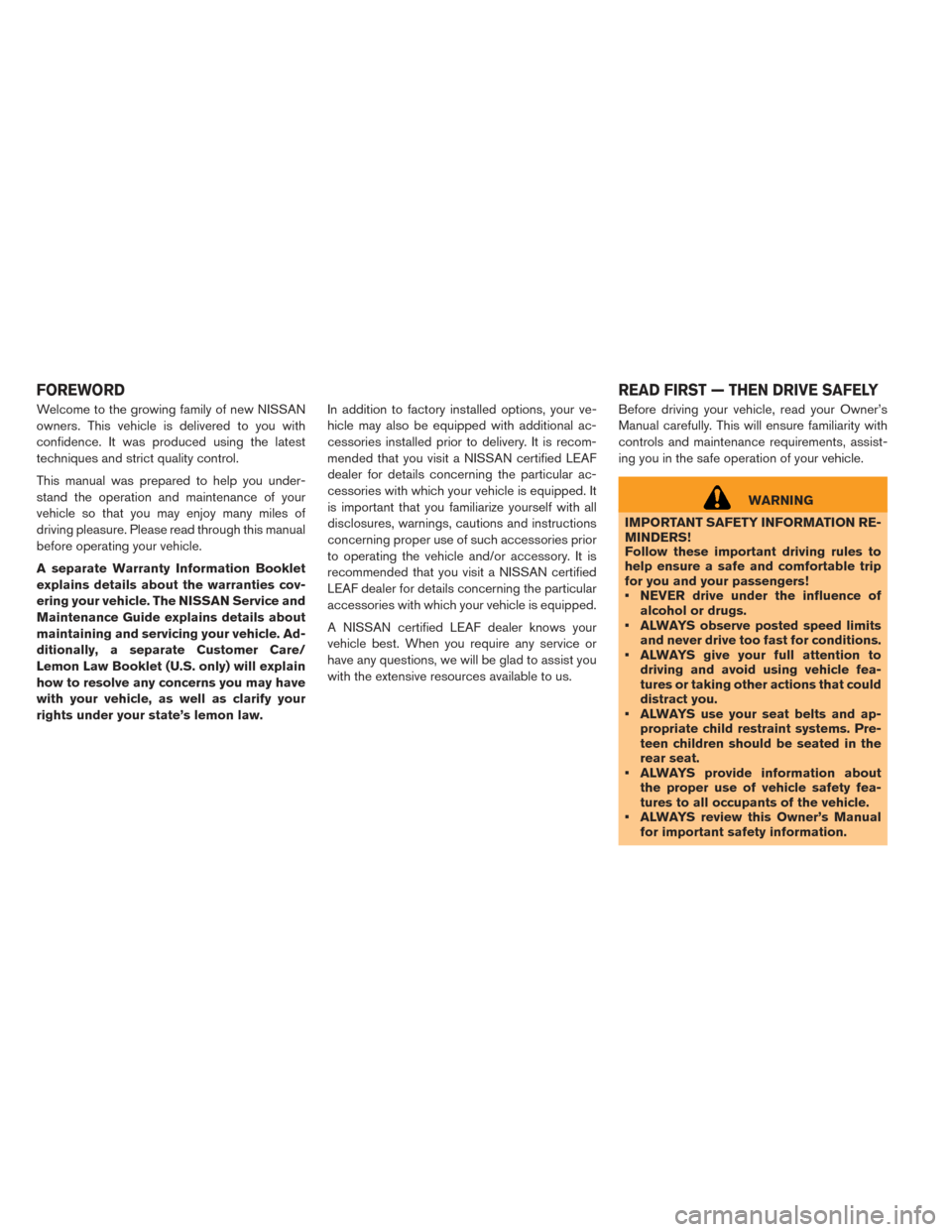
Welcome to the growing family of new NISSAN
owners. This vehicle is delivered to you with
confidence. It was produced using the latest
techniques and strict quality control.
This manual was prepared to help you under-
stand the operation and maintenance of your
vehicle so that you may enjoy many miles of
driving pleasure. Please read through this manual
before operating your vehicle.
A separate Warranty Information Booklet
explains details about the warranties cov-
ering your vehicle. The NISSAN Service and
Maintenance Guide explains details about
maintaining and servicing your vehicle. Ad-
ditionally, a separate Customer Care/
Lemon Law Booklet (U.S. only) will explain
how to resolve any concerns you may have
with your vehicle, as well as clarify your
rights under your state’s lemon law.In addition to factory installed options, your ve-
hicle may also be equipped with additional ac-
cessories installed prior to delivery. It is recom-
mended that you visit a NISSAN certified LEAF
dealer for details concerning the particular ac-
cessories with which your vehicle is equipped. It
is important that you familiarize yourself with all
disclosures, warnings, cautions and instructions
concerning proper use of such accessories prior
to operating the vehicle and/or accessory. It is
recommended that you visit a NISSAN certified
LEAF dealer for details concerning the particular
accessories with which your vehicle is equipped.
A NISSAN certified LEAF dealer knows your
vehicle best. When you require any service or
have any questions, we will be glad to assist you
with the extensive resources available to us.
Before driving your vehicle, read your Owner’s
Manual carefully. This will ensure familiarity with
controls and maintenance requirements, assist-
ing you in the safe operation of your vehicle.
WARNING
IMPORTANT SAFETY INFORMATION RE-
MINDERS!
Follow these important driving rules to
help ensure a safe and comfortable trip
for you and your passengers!
• NEVER drive under the influence of alcohol or drugs.
• ALWAYS observe posted speed limits and never drive too fast for conditions.
• ALWAYS give your full attention to driving and avoid using vehicle fea-
tures or taking other actions that could
distract you.
• ALWAYS use your seat belts and ap- propriate child restraint systems. Pre-
teen children should be seated in the
rear seat.
• ALWAYS provide information about the proper use of vehicle safety fea-
tures to all occupants of the vehicle.
• ALWAYS review this Owner’s Manual for important safety information.
FOREWORD READ FIRST — THEN DRIVE SAFELY
Page 3 of 424
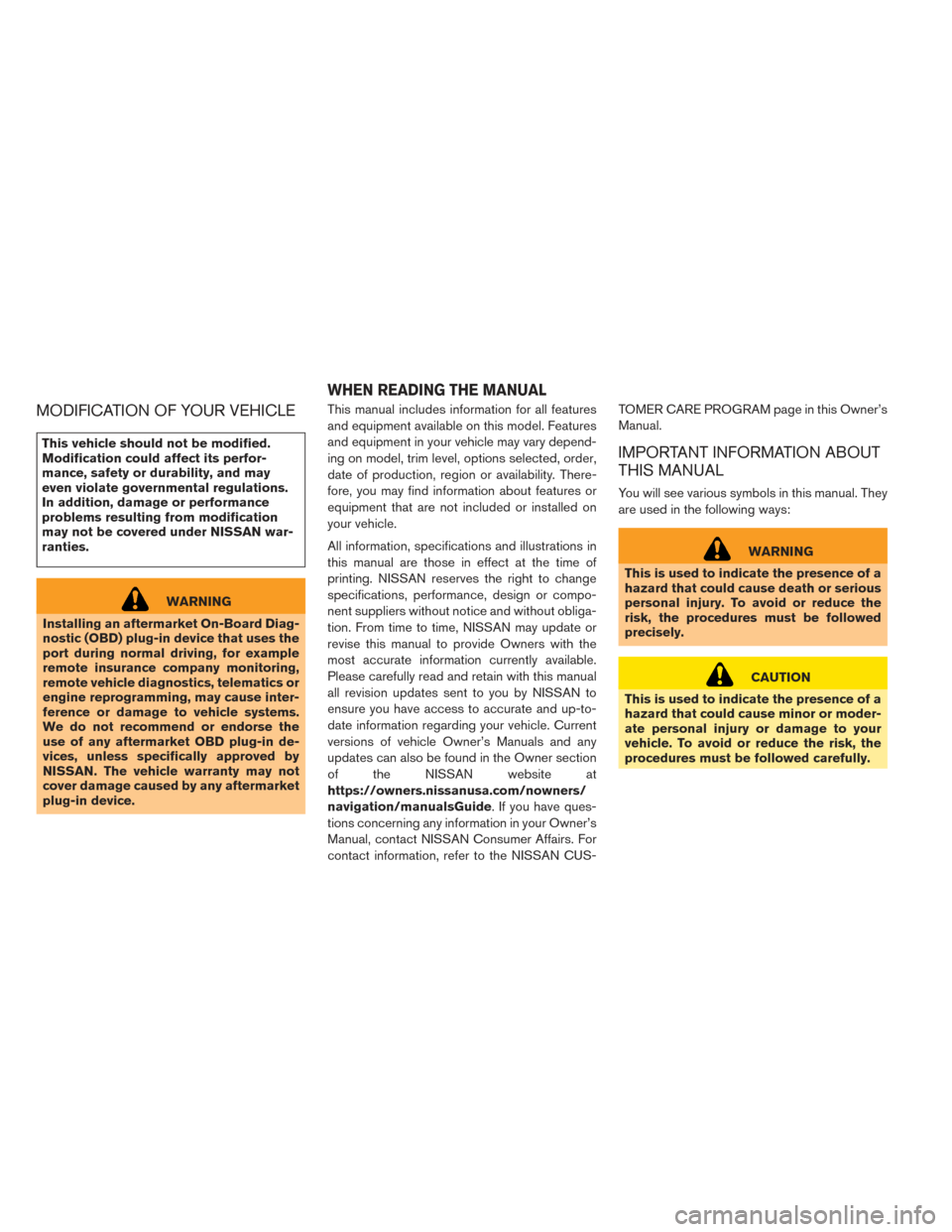
MODIFICATION OF YOUR VEHICLE
This vehicle should not be modified.
Modification could affect its perfor-
mance, safety or durability, and may
even violate governmental regulations.
In addition, damage or performance
problems resulting from modification
may not be covered under NISSAN war-
ranties.
WARNING
Installing an aftermarket On-Board Diag-
nostic (OBD) plug-in device that uses the
port during normal driving, for example
remote insurance company monitoring,
remote vehicle diagnostics, telematics or
engine reprogramming, may cause inter-
ference or damage to vehicle systems.
We do not recommend or endorse the
use of any aftermarket OBD plug-in de-
vices, unless specifically approved by
NISSAN. The vehicle warranty may not
cover damage caused by any aftermarket
plug-in device. This manual includes information for all features
and equipment available on this model. Features
and equipment in your vehicle may vary depend-
ing on model, trim level, options selected, order,
date of production, region or availability. There-
fore, you may find information about features or
equipment that are not included or installed on
your vehicle.
All information, specifications and illustrations in
this manual are those in effect at the time of
printing. NISSAN reserves the right to change
specifications, performance, design or compo-
nent suppliers without notice and without obliga-
tion. From time to time, NISSAN may update or
revise this manual to provide Owners with the
most accurate information currently available.
Please carefully read and retain with this manual
all revision updates sent to you by NISSAN to
ensure you have access to accurate and up-to-
date information regarding your vehicle. Current
versions of vehicle Owner’s Manuals and any
updates can also be found in the Owner section
of the NISSAN website at
https://owners.nissanusa.com/nowners/
navigation/manualsGuide. If you have ques-
tions concerning any information in your Owner’s
Manual, contact NISSAN Consumer Affairs. For
contact information, refer to the NISSAN CUS- TOMER CARE PROGRAM page in this Owner’s
Manual.
IMPORTANT INFORMATION ABOUT
THIS MANUAL
You will see various symbols in this manual. They
are used in the following ways:
WARNING
This is used to indicate the presence of a
hazard that could cause death or serious
personal injury. To avoid or reduce the
risk, the procedures must be followed
precisely.
CAUTION
This is used to indicate the presence of a
hazard that could cause minor or moder-
ate personal injury or damage to your
vehicle. To avoid or reduce the risk, the
procedures must be followed carefully.
WHEN READING THE MANUAL
Page 4 of 424
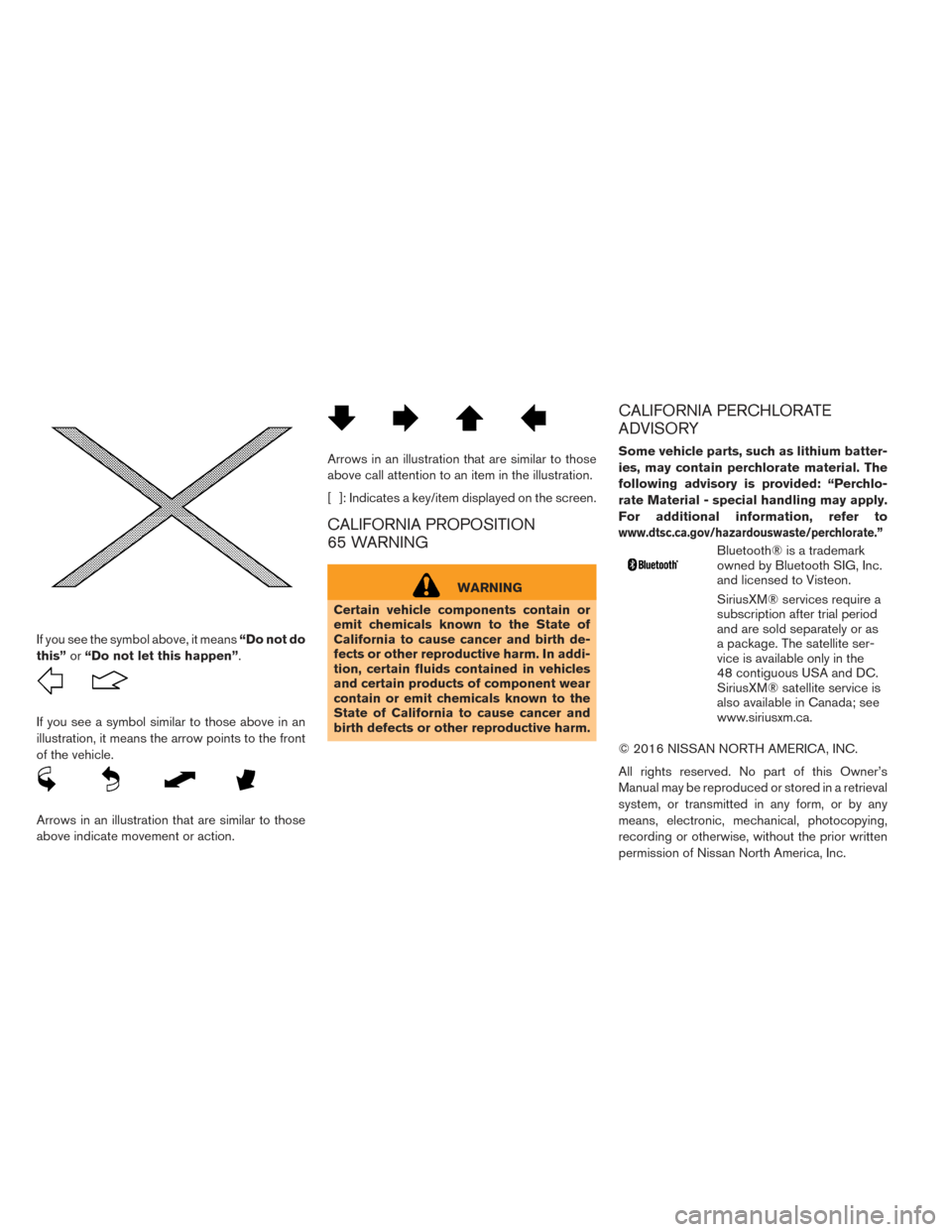
If you see the symbol above, it means“Do not do
this” or“Do not let this happen”.
If you see a symbol similar to those above in an
illustration, it means the arrow points to the front
of the vehicle.
Arrows in an illustration that are similar to those
above indicate movement or action.
Arrows in an illustration that are similar to those
above call attention to an item in the illustration.
[ ]: Indicates a key/item displayed on the screen.
CALIFORNIA PROPOSITION
65 WARNING
WARNING
Certain vehicle components contain or
emit chemicals known to the State of
California to cause cancer and birth de-
fects or other reproductive harm. In addi-
tion, certain fluids contained in vehicles
and certain products of component wear
contain or emit chemicals known to the
State of California to cause cancer and
birth defects or other reproductive harm.
CALIFORNIA PERCHLORATE
ADVISORY
Some vehicle parts, such as lithium batter-
ies, may contain perchlorate material. The
following advisory is provided: “Perchlo-
rate Material - special handling may apply.
For additional information, refer to
www.dtsc.ca.gov/hazardouswaste/perchlorate.”
Bluetooth® is a trademark
owned by Bluetooth SIG, Inc.
and licensed to Visteon.
SiriusXM® services require a
subscription after trial period
and are sold separately or as
a package. The satellite ser-
vice is available only in the
48 contiguous USA and DC.
SiriusXM® satellite service is
also available in Canada; see
www.siriusxm.ca.
© 2016 NISSAN NORTH AMERICA, INC.
All rights reserved. No part of this Owner’s
Manual may be reproduced or stored in a retrieval
system, or transmitted in any form, or by any
means, electronic, mechanical, photocopying,
recording or otherwise, without the prior written
permission of Nissan North America, Inc.
Page 8 of 424
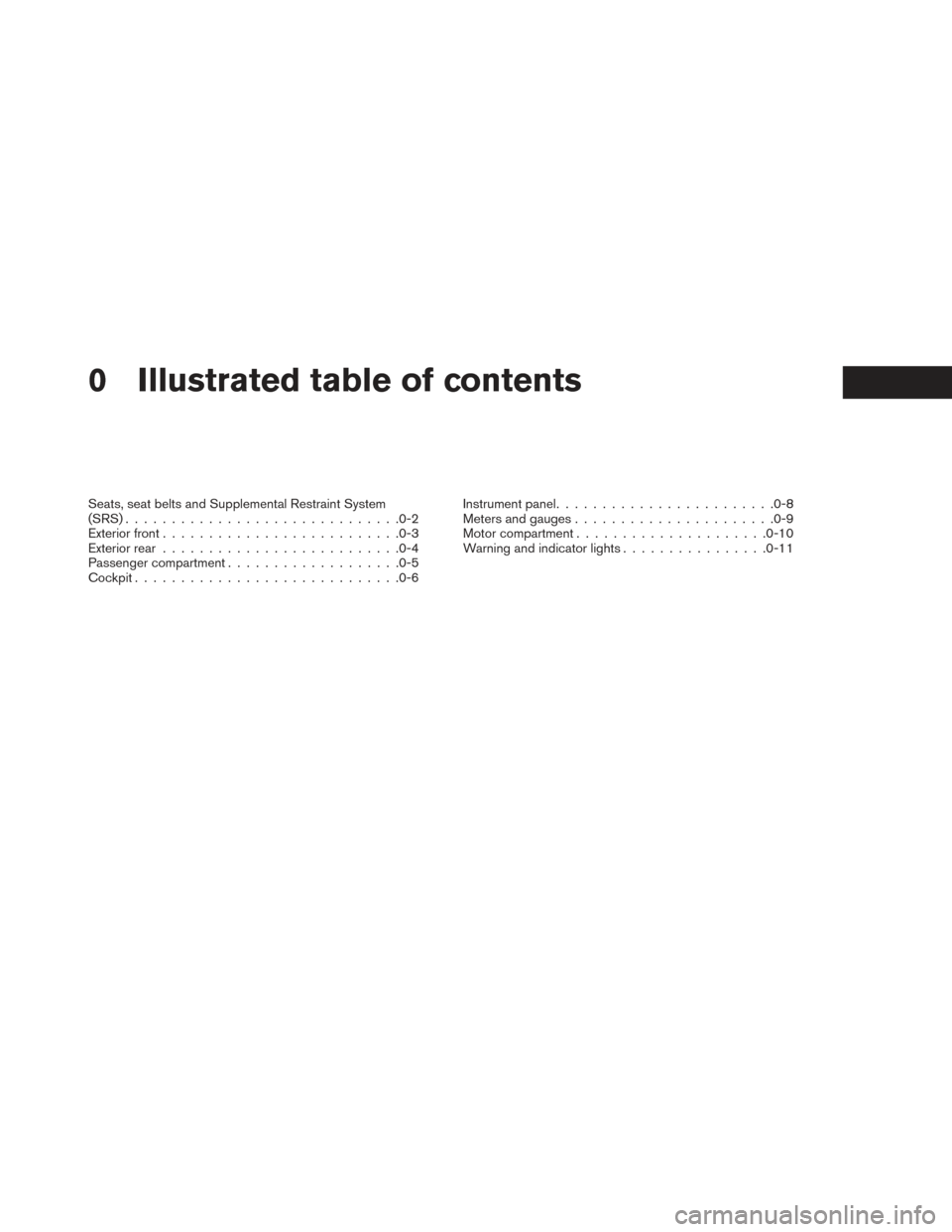
0 Illustrated table of contents
Seats, seat belts and Supplemental Restraint System
(SRS)............................. .0-2
Exterior front ......................... .0-3
Exterior rear ......................... .0-4
Passenger compartment .................. .0-5
Cockpit ............................ .0-6Instrument panel
....................... .0-8
Meters and gauges ..................... .0-9
Motor compartment .................... .0-10
Warning and indicator lights ................0-11
Page 15 of 424
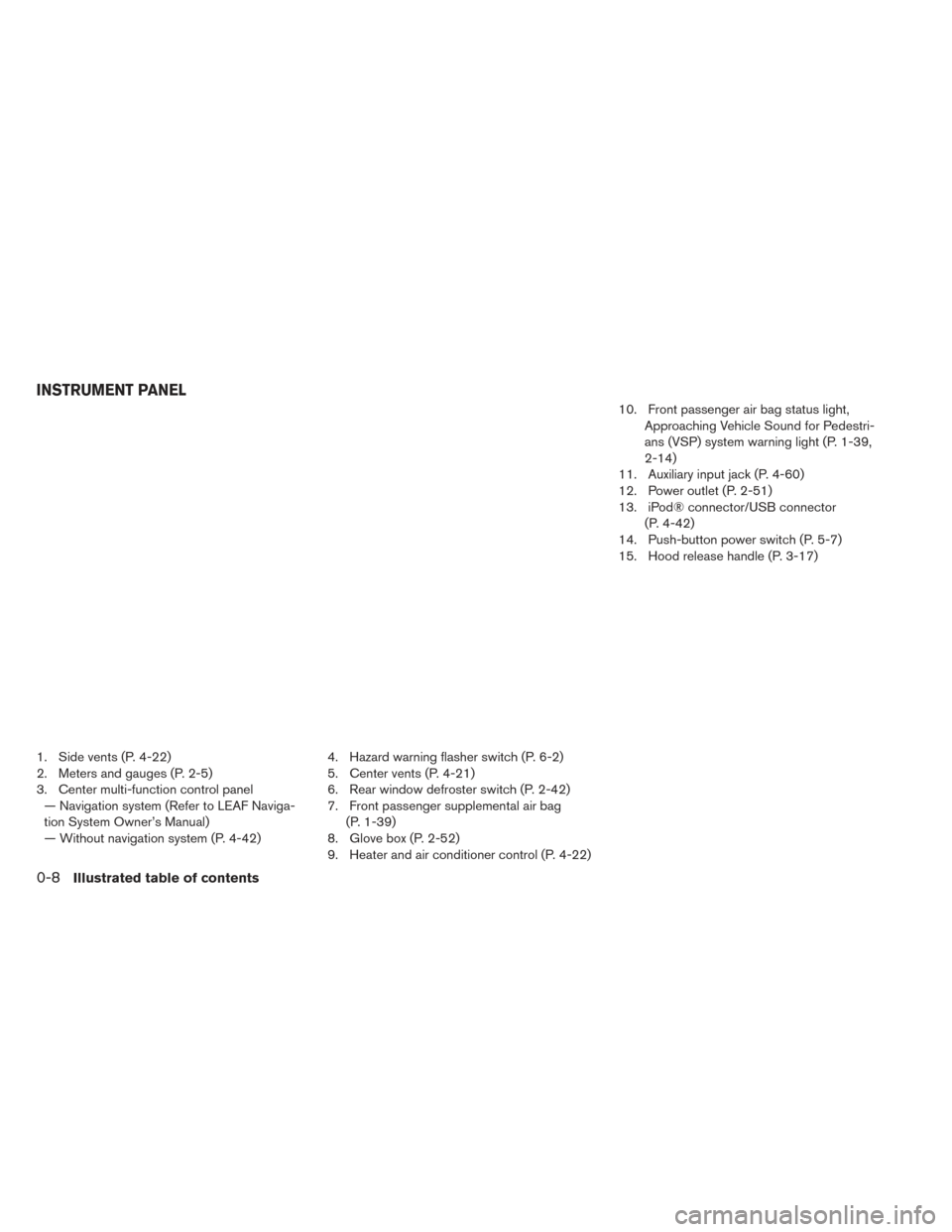
1. Side vents (P. 4-22)
2. Meters and gauges (P. 2-5)
3. Center multi-function control panel— Navigation system (Refer to LEAF Naviga-
tion System Owner’s Manual)
— Without navigation system (P. 4-42) 4. Hazard warning flasher switch (P. 6-2)
5. Center vents (P. 4-21)
6. Rear window defroster switch (P. 2-42)
7. Front passenger supplemental air bag
(P. 1-39)
8. Glove box (P. 2-52)
9. Heater and air conditioner control (P. 4-22) 10. Front passenger air bag status light,
Approaching Vehicle Sound for Pedestri-
ans (VSP) system warning light (P. 1-39,
2-14)
11. Auxiliary input jack (P. 4-60)
12. Power outlet (P. 2-51)
13. iPod® connector/USB connector (P. 4-42)
14. Push-button power switch (P. 5-7)
15. Hood release handle (P. 3-17)
INSTRUMENT PANEL
0-8Illustrated table of contents
Page 16 of 424
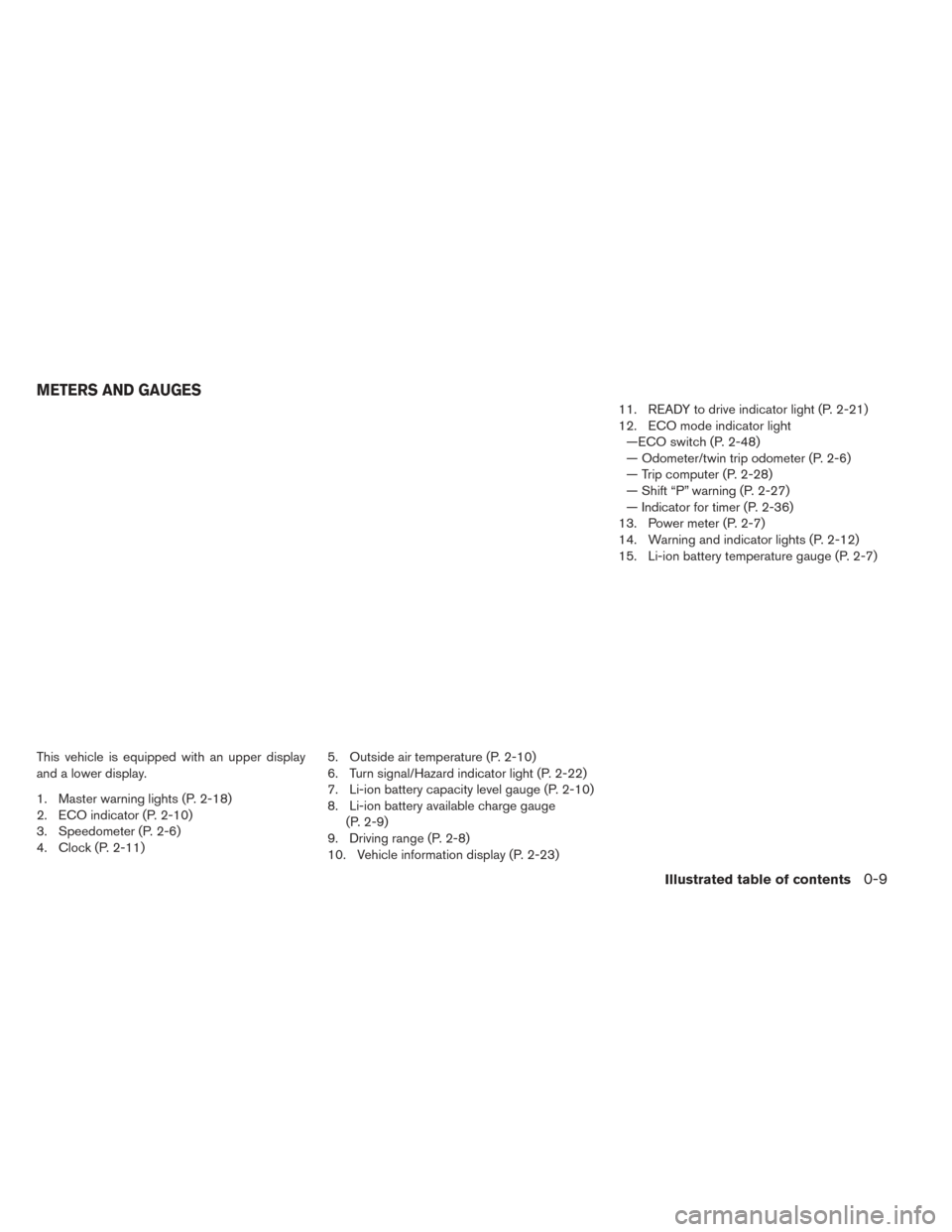
This vehicle is equipped with an upper display
and a lower display.
1. Master warning lights (P. 2-18)
2. ECO indicator (P. 2-10)
3. Speedometer (P. 2-6)
4. Clock (P. 2-11)5. Outside air temperature (P. 2-10)
6. Turn signal/Hazard indicator light (P. 2-22)
7. Li-ion battery capacity level gauge (P. 2-10)
8. Li-ion battery available charge gauge
(P. 2-9)
9. Driving range (P. 2-8)
10. Vehicle information display (P. 2-23) 11. READY to drive indicator light (P. 2-21)
12. ECO mode indicator light
—ECO switch (P. 2-48)
— Odometer/twin trip odometer (P. 2-6)
— Trip computer (P. 2-28)
— Shift “P” warning (P. 2-27)
— Indicator for timer (P. 2-36)
13. Power meter (P. 2-7)
14. Warning and indicator lights (P. 2-12)
15. Li-ion battery temperature gauge (P. 2-7)
METERS AND GAUGES
Illustrated table of contents0-9
Page 18 of 424
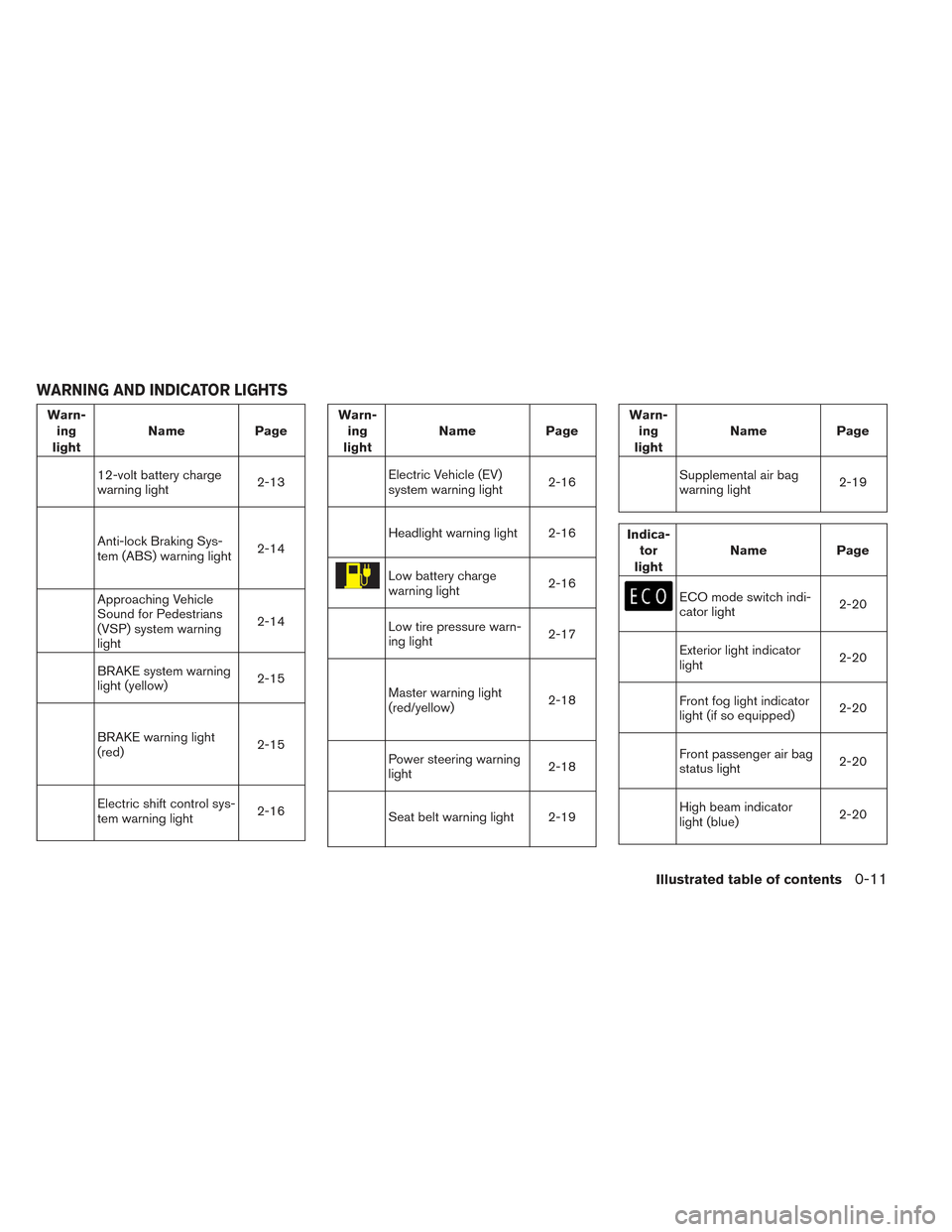
Warn-ing
light Name
Page
12-volt battery charge
warning light 2-13
Anti-lock Braking Sys-
tem (ABS) warning light2-14
Approaching Vehicle
Sound for Pedestrians
(VSP) system warning
light2-14
BRAKE system warning
light (yellow)
2-15
BRAKE warning light
(red)2-15
Electric shift control sys-
tem warning light2-16
Warn-
ing
light Name
Page
Electric Vehicle (EV)
system warning light 2-16
Headlight warning light 2-16
Low battery charge
warning light2-16
Low tire pressure warn-
ing light2-17
Master warning light
(red/yellow)2-18
Power steering warning
light2-18
Seat belt warning light 2-19
Warn-
ing
light Name
Page
Supplemental air bag
warning light 2-19
Indica-
tor
light Name
Page
ECO mode switch indi-
cator light 2-20
Exterior light indicator
light2-20
Front fog light indicator
light (if so equipped)2-20
Front passenger air bag
status light2-20
High beam indicator
light (blue)2-20
WARNING AND INDICATOR LIGHTS
Illustrated table of contents0-11
Page 21 of 424
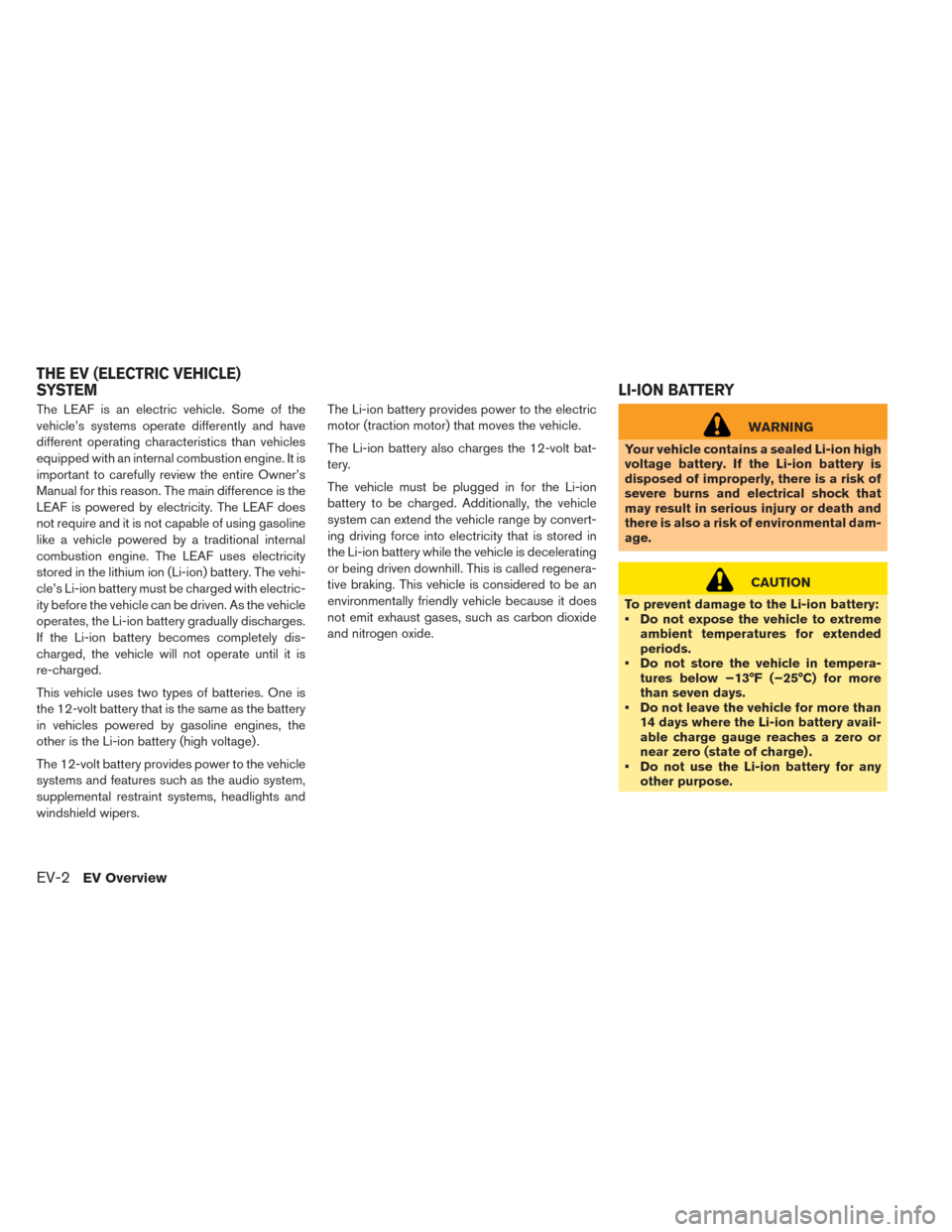
The LEAF is an electric vehicle. Some of the
vehicle’s systems operate differently and have
different operating characteristics than vehicles
equipped with an internal combustion engine. It is
important to carefully review the entire Owner’s
Manual for this reason. The main difference is the
LEAF is powered by electricity. The LEAF does
not require and it is not capable of using gasoline
like a vehicle powered by a traditional internal
combustion engine. The LEAF uses electricity
stored in the lithium ion (Li-ion) battery. The vehi-
cle’s Li-ion battery must be charged with electric-
ity before the vehicle can be driven. As the vehicle
operates, the Li-ion battery gradually discharges.
If the Li-ion battery becomes completely dis-
charged, the vehicle will not operate until it is
re-charged.
This vehicle uses two types of batteries. One is
the 12-volt battery that is the same as the battery
in vehicles powered by gasoline engines, the
other is the Li-ion battery (high voltage) .
The 12-volt battery provides power to the vehicle
systems and features such as the audio system,
supplemental restraint systems, headlights and
windshield wipers.The Li-ion battery provides power to the electric
motor (traction motor) that moves the vehicle.
The Li-ion battery also charges the 12-volt bat-
tery.
The vehicle must be plugged in for the Li-ion
battery to be charged. Additionally, the vehicle
system can extend the vehicle range by convert-
ing driving force into electricity that is stored in
the Li-ion battery while the vehicle is decelerating
or being driven downhill. This is called regenera-
tive braking. This vehicle is considered to be an
environmentally friendly vehicle because it does
not emit exhaust gases, such as carbon dioxide
and nitrogen oxide.
WARNING
Your vehicle contains a sealed Li-ion high
voltage battery. If the Li-ion battery is
disposed of improperly, there is a risk of
severe burns and electrical shock that
may result in serious injury or death and
there is also a risk of environmental dam-
age.
CAUTION
To prevent damage to the Li-ion battery:
• Do not expose the vehicle to extreme ambient temperatures for extended
periods.
• Do not store the vehicle in tempera- tures below −13°F (−25°C) for more
than seven days.
• Do not leave the vehicle for more than 14 days where the Li-ion battery avail-
able charge gauge reaches a zero or
near zero (state of charge) .
• Do not use the Li-ion battery for any other purpose.
THE EV (ELECTRIC VEHICLE)
SYSTEM LI-ION BATTERY
EV-2EV Overview